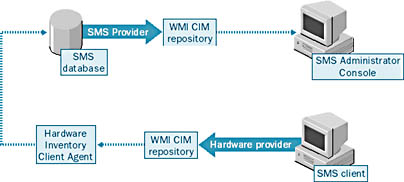Understanding WBEM and WMI
WBEM is an industry initiative adopted by the Desktop Management Task Force (DMTF) to implement a common interface between management applications, such as SMS, and management entities, such as SMS objects. SMS objects include discovery data, client computers, packages, advertisements, sites, and site control information. This common interface is called the Common Information Model (CIM) repository. It defines a standard schema for storing and exposing object data. Providers are components that collect object information from managed objects and store them in the CIM repository. A management application can then obtain that information from the CIM repository and make it available for view and analysis.
This interface feature is similar to installing a Windows device driver such as a printer driver. The print device manufacturer provides a printer driver that is compatible with Windows operating systems. All Windows-based applications use this same printer driver to generate print jobs on the print device. Using a similar premise, with the WBEM interface installed, any management application program should be able to obtain workstation data from any workstation running any operating system. The implementation of the WBEM interface into a particular operating system environment is the responsibility of the operating system manufacturer. Microsoft's implementation of WBEM, the WMI, provides its own CIM Object Manager, or repository. Providers can be written to store and expose data in the CIM repository, and management applications (written with Microsoft Visual Basic, SQL Server, Java, ODBC, Active Directory Service, and so on) can be created to obtain that data from the CIM repository.
To illustrate, suppose a hardware provider on the SMS client stores SMS object information such as hardware inventory in the CIM repository. SMS agents such as the Hardware Inventory Client Agent extract that data from the CIM repository and report it to the SMS database. The SMS Provider, which can be installed on the SMS site server or the SQL Server, accesses the SMS database to provide the data to the SMS Administrator Console. Figure 1-3 demonstrates this relationship.

Figure 1-3. Relationship between the SMS Provider, the WMI, and the SMS database.
The SMS database objects, views, and tables are not directly accessible or modifiable except through the WMI layer. SMS provides an open architecture, however, which makes it possible to create tools other than the SMS Administrator Console that can access and manipulate the SMS database objects. In essence, any WBEM-compliant and ODBC-compliant application can be used to access these objects. So you could view the data with a Web browser using ActiveX controls or Java, through applications written using C++, Visual Basic, or the Component Object Model (COM).
WMI is installed on all 32-bit SMS clients, including Windows 95/98, Windows NT 4.0 or later, and requires about 8 MB of disk space. The registry is modified to reflect the WMI component installation, and the Windows Management Service is installed and started.
![]()
MORE INFO
For more information about Microsoft Windows Management Instrumentation see the white paper "Microsoft Windows Management Instrumentation: Background and Overview" on one of the companion CDs included with this book.
EAN: 2147483647
Pages: 167